PROBLEMS ON COMPLEMENTARY AND SUPPLEMENTARY ANGLES
Subscribe to our ▶️ YouTube channel 🔴 for the latest videos, updates, and tips.
Complementary Angles :
The two angles whose sum is 90˚

Supplementary Angles :
The two angles whose sum is 180˚
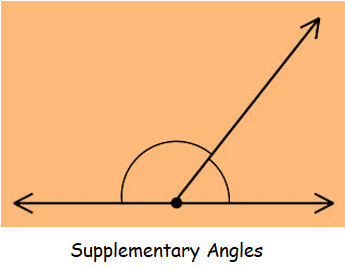
In each case. find the missing angle :
Example 1 :
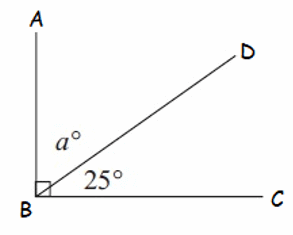
Solution :
In the diagram shown above, ∠ABD and∠DBC are complementary angles.
∠ABD + ∠DBC = 90°
Substitute ∠ABD = a° and ∠DBC = 25°.
a° + 25° = 90°
Subtract 25° from both sides.
a° = 65°
Example 2 :
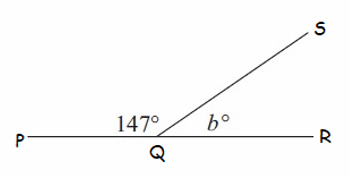
Solution :
In the diagram shown above, ∠PQS and∠SQR are complementary angles.
∠PQS + ∠SQR = 180°
Substitute ∠PQS = 147° and ∠SQR = b°.
147° + b° = 180°
Subtract 147° from both sides.
b° = 33°
Example 3 :
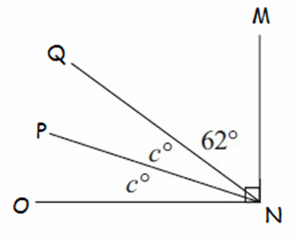
Solution :
In the diagram shown above, ∠MNQ, ∠QNP, and ∠PNO are complementary angles.
∠MNQ + ∠QNP + ∠PNO = 90°
Substitute ∠MNQ = 62°, ∠QNP = c° and ∠PNO = c°.
62° + c° + c° = 90°
62° + 2c° = 90°
Subtract 62° from both sides.
2c° = 28°
Divide both sides by 2.
c = 14°
Example 4 :

Solution :
In the diagram shown above, ∠ABE, ∠EBD and ∠DBC are supplementary angles.
∠ABE + ∠EBD + ∠DBC = 180°
Substitute ∠ABE = d°, ∠EBD = 90° and ∠DBC = 30°.
d° + 90° + 30° = 180°
d° + 120° = 180°
Subtract 120° from both sides.
d° = 60°
Example 5 :

Solution :
In the diagram shown above, ∠MNQ, ∠QNP, and ∠PNO are complementary angles.
m∠MNQ + m∠QNP + m∠PNO = 90°
Substitute ∠MNQ = 12°, ∠QNP = e° and ∠PNO = 33°.
12° + e° + 33° = 90°
45° + e° = 90°
Subtract 45° from both sides.
e = 45°
Example 6 :

Solution :
In the diagram shown above, ∠MNQ, ∠QNP, and ∠PNO are complementary angles.
∠MNQ + ∠QNP + ∠PNO = 90°
Substitute ∠MNQ = f°, ∠QNP = f° and ∠PNO = 38°.
f° + f° + 38° = 90°
2f° + 38° = 90°
Subtract 38° from both sides.
2f° = 52°
Divide both sides by 2.
f = 26°
Example 7 :
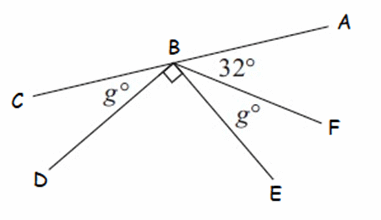
Solution :
In the diagram shown above, ∠ABF, ∠FBE, ∠EBD and ∠DBC are supplementary angles.
∠ABF + ∠FBE + ∠EBD + ∠DBC = 180°
Substitute ∠ABF = 32°, ∠EBD = 90° and∠FBE = ∠DBC = g°.
32° + g° + 90° + g° = 180°
2g° + 122° = 180°
Subtract 122° from both sides.
2g˚ = 58°
Divide both sides by 2.
g° = 29°
Example 8 :

Solution :
∠ABF, ∠FBE, ∠EBD and ∠DBC are supplementary angles.
∠ABF + ∠FBE + ∠EBD + ∠DBC = 180°
Substitute ∠ABF = h°, ∠FBE = 48°, ∠EBD = h°, ∠DBC = 74°
h° + 48° + h° + 74° = 180°
2h° + 122° = 180°
Subtract 122° from both sides.
2h° = 58°
Divide both sides by 2.
h = 29°
Example 9 :

Solution :
In the diagram shown above, ∠ABE, ∠EBD and ∠DBC are supplementary angles.
∠ABE + ∠EBD + ∠DBC = 180°
Substitute ∠ABE = ∠EBD = ∠DBC = x°.
x° + x° + x° = 180°
3x° = 180˚
Divide both sides by 3.
x = 60°
Example 10 :
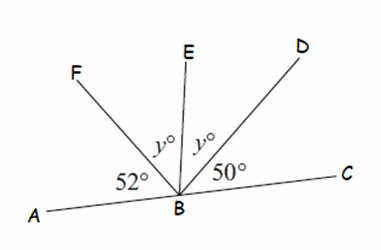
Solution :
In the diagram shown above, ∠ABF, ∠FBE, ∠EBD and ∠DBC are supplementary angles.
∠ABF + ∠FBE + ∠EBD + ∠DBC = 180°
Substitute ∠ABF = 52°, ∠FBE = ∠EBD = y°, ∠DBC = 50°.
52° + y° + y° + 50° = 180°
2y° + 102° = 180°
Subtract 102° from both sides.
2y° = 78°
Divide both sides by 2.
y = 39°
Subscribe to our ▶️ YouTube channel 🔴 for the latest videos, updates, and tips.
Kindly mail your feedback to v4formath@gmail.com
We always appreciate your feedback.
About Us | Contact Us | Privacy Policy
©All rights reserved. onlinemath4all.com

Recent Articles
-
10 Hard SAT Math Questions (Part - 42)
Dec 30, 25 05:52 AM
10 Hard SAT Math Questions (Part - 42) -
10 Hard SAT Math Questions (Part - 38)
Dec 29, 25 04:21 AM
10 Hard SAT Math Questions (Part - 38) -
10 Hard SAT Math Questions (Part - 39)
Dec 28, 25 11:20 PM
10 Hard SAT Math Questions (Part - 39)
